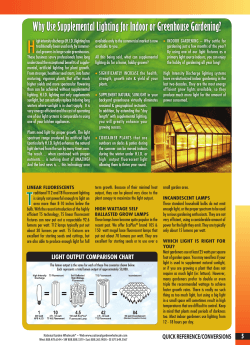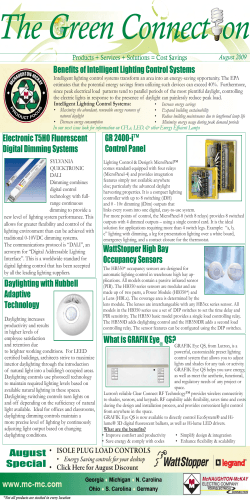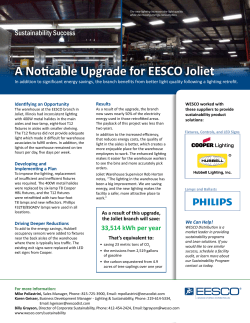
How to successfully bid lighting upgrades Application Note
How to successfully bid lighting upgrades Application Note Building owners and facility managers are looking for the right electrical contractor to implement lighting upgrades. Knowing how to successfully bid and execute a lighting upgrade project is the key to winning these contracts. Fortunately, the tools are readily available to join this emerging market. Measuring kW energy consumption will give you a more accurate bid, in far less time, than estimating off of total fixtures. It is no secret that both lighting manufacturers and utilities are approaching building managers with incentives to replace existing lighting systems with more energy efficient systems. Lighting costs can account for between 30 to and 40 percent of a building’s energy cost. Certainly, facility managers are looking to save money. But, add-in these kickers: Utilities are offering significant rebates and financial incentives that directly reduce the cost of the upgrade and also shorten the payback period. And, tax incentives have just recently been extended for many energy savings projects, including lighting. For example, upgrading to energy efficient lighting can mean up to a $0.60 per square foot tax deduction for building owners. And, as far as electrical contractors are concerned, electrical lighting manufacturers are more than happy to provide the dollar cost savings numbers to prove to the building owner the significant return on investment that can be achieved with a lighting retrofit. Like bidding any job, the key to a successful proposal is minimizing preparation time while achieving accuracy. Using the right tools to prepare the winning bid is a must. The focus of this article is just that; the test equipment you can use to quickly and accurately capture the data you need and capitalize on this growing market. The process of gathering data and determining the dollar savings for the building owner is done by conducting a “Lighting Audit.” That same audit is the proof of the pudding as to whether your proposal will be successful. To conduct a quick and accurate lighting audit and win the job, perform these steps: • Contact your lighting supplier. They will most likely have the software you need to conduct the lighting audit and prove the energy savings to the building owner. By factoring in your bid amount, you will be able to provide the client the number of months to realize the return on their lighting upgrade investment. Often this software is available right on the manufacturer’s website. • Gather existing data at the facility. The software will specify the data needed and typically help you take into account lighting loss and utilization factors that will help determine the best lighting solution for your client. From the Fluke Digital Library @ www.fluke.com/library • Prepare the bid demonstrating how many dol- lars your retrofit will save the building owner per year when compared to their current system. You can also point out the potential savings the owner should explore through utility and tax incentives. Depending on the lighting manufacturer software you use to prepare your audit results, you will typically need the following information: • number and type of fixtures, lamps in each fixture, and any ballasts in use • room square footage and height from ceiling to floor • current foot-candle or lux levels in the room • current energy consumption in kilowatts • estimated hours per day of usage Don’t let gathering this data slow you down. As you walk through the facility, identify the type and usage of each room (office area, warehouse, restroom, etc.) and record the number and types of fixtures. For typical fixtures in use, record the following data: number of lamps per fixture, lamp type, wattage per lamp, and related ballasts, as applicable. Do not worry about inspecting each individual fixture in a facility for lamp types. Some floor areas may have more than one type fluorescent lamp installed in the same fixture simply because that is what the maintenance department had available at the time! You’ll compensate for any mis-matches here during the kilowatt-usage tracking you do later. Next, measure the dimensions of each room. Do not waste time here with a tape measure and additional person. Use a laser distance meter. For example, if the room is square or rectangular, you can quickly, and with amazing accuracy, determine the square footage by standing in one corner of the room for all measurements. Push the appropriate button on the distance meter to read “area.” Place the meter on one wall and shoot the laser at the opposite wall. Then, place the meter on the adjacent wall right next to you and shoot at the opposite wall. Look at your meter and you now have the square footage of the room. Then, set the meter to measure length and place the meter on the floor pointing at the ceiling. Press the measure button again to determine floor-toceiling height. You now have all the dimensions you need to input into your software. Next determine the footcandles in the room. A footcandle is a measure of the illumination or lighting levels in the room. The technical term you may see in the manufacturer’s software for this illumination level is illuminance. Lux is the metric unit of measurement for illuminance. One footcandle is approximately ten lux. As a practical example, office areas are generally lit to an illuminance of ten to thirty footcandles. Laser distance meters are another way to both save time and improve the accuracy of your bid. To measure illuminance, use a light meter that allows you to select footcandles or Lux as the unit of measurement. Turn on the meter and press the “Zero” button with the cover over the sensor to automatically adjust the meter to zero. Select whether to read out in footcandles or lux. Remove the cap from the sensor and survey the room for illuminance levels by holding the sensor perpendicular to the light source. Your lighting supplier will need to know how much illuminance is required for the space. You will enter the footcandles, (or lux), as read on your light meter into the software. Use a light meter that allows you to select footcandles to measure illuminance. 2 Fluke Corporation How to successfully bid lighting upgrades Don’t try to estimate lighting energy consumption levels. You would have to inspect each Understanding lighting levels and fixture, verify the wattage of each individual lamp, lighting energy consumption and then total the wattage of all the lamps on an individual circuit. Just measure it, instead! Use a The Illuminating Engineering Society (IES) of North America test tool designed to measure energy consump(www.iesna.org) publishes guidelines for lighting levels for diftion. A single-phase power quality clamp meter is ferent types of areas or spaces. These levels are based on the a good choice for a lighting contractor. As simple tasks performed in the area, the size of objects handled, the as using a clamp-on ammeter, the power quality detail required and, the average age of the people in that area in clamp meter will quickly and easily provide the addition to other factors. wattage data needed. Set the meter to read watts. Illuminance is the lighting level and is expressed in either Attach the test probes to read circuit voltage for “footcandles” or “lux.” A Lumen is a measure of the quantity of the circuit under test. Then, clamp around the light emitted by a source. A Footcandle (fc) is a unit of measure to branch circuit conductor supplying the lighting represent the illuminance or light falling onto a surface. One footcircuit you wish to measure. Turn the lights off candle is equal to one lumen per square foot. Lux (lx) is a unit of and on to verify the actual wattage usage of the metric measurement to represent the illuminance or light falling lighting circuit. The meter will read in watts (W) onto a surface. One lux is equal to one lumen per square meter. or kilowatts (kW) as appropriate. For example, a 60-watt soft-white incandescent lamp provides One extremely important safety note when about 840 lumens of light. If three of these lamps are lighting an measuring wattage: If you find yourself in a area of 100 square feet, then: panelboard clamping around the ungrounded Lumens = 3 x 840 = 2,520 lumens total conductor off the breaker for a lighting branch Footcandles = lumens/square foot = 2,520/100 = 25.2 fc circuit, be sure to follow the safety rules specified To determine energy consumption if the lamps are operating in NFPA 70E, Standard for Electrical Safety in the 2,000 hours per year: Workplace, for work involving electrical hazards. Total wattage = 3 x 60 = 180 watts total Remember, no job is worth risking physical injury! Watthours = watts total x number of hours of operation = Discuss with the building owner, manager, 180 watts x 2,000 hours = 360,000 watthours, or and occupants how many hours per day specific Kilowatt Hours (kWh) = watthours/1,000 = 360,000/1,000 = lighting circuits are in use. Multiply your watts, 360 kWh (or kw), reading obtained with the power qualIf average utility costs for the facility are 10 cents per kWh, ity clamp meter by the total hours that particular then, to determine the total energy costs for one year of operating lighting circuit is in operation each day. This will the three 60 watt incandescent lamps: give you the kilowatt hours (kWh) of energy usage Energy Cost = cost per kWh x kWh = 10 cents x 360 kWh = for that circuit for one day. Input the kWh cost $36.00 per year charged by the utility and actual kWh consumed A compact fluorescent lamp producing approximately the same into the software to show the building owner the lumens of light as individual 60 watt incandescent lamps does actual dollar figure of their current lighting costs. so by consuming only 13 watts of electrical energy. To determine The lighting manufacturer’s software will take the cost savings, first calculate the new kilowatt hours of energy care of the rest. It will help you determine which to be consumed: energy efficient lighting fixtures and lamps to Total wattage = 3 x 13 watts = 39 watts total recommend and calculate the actual cost savings Watthours = 39 watts x 2,000 hours = 78,000 watthours, or dollar figure, while still meeting or exceeding curKilowatt Hours (kWh) = watthours/1,000 = 78,000/1,000 = rent light levels in each area. 78 kWh The competition for lighting upgrades can be Energy Cost = cost per kWh x kWh = 10 cents x 78 kWh = $7.80 stiff. However, in today’s energy conscious market, per year fueled by utility and tax incentives, there is plenty Energy Savings = Current Cost – Cost after Lighting Upgrade of retrofit work available. Building owners want to = $36.00 - $7.80 = $28.20 per year savings for three fixtures! save up to 30 to 40 percent of their total energy costs. By using the right tools, electrical contractors can prepare quick and accurate proposals. Fluke.Keeping your world up and running.® Deliver concrete numbers that show the client black and white dollars savings and time required Fluke Corporation For more information call: to see return on investment. PO Box 9090, Everett, WA 98206 U.S.A. Fluke Europe B.V. PO Box 1186, 5602 BD Eindhoven, The Netherlands Modification of this document is not permitted without written permission from Fluke Corporation. 3 Fluke Corporation How to successfully bid lighting upgrades In the U.S.A. (800) 443-5853 or Fax (425) 446-5116 In Europe/M-East/Africa +31 (0) 40 2675 200 or Fax +31 (0) 40 2675 222 In Canada (800)-36-FLUKE or Fax (905) 890-6866 From other countries +1 (425) 446-5500 or Fax +1 (425) 446-5116 Web access: http://www.fluke.com ©2009 Fluke Corporation. Specifications subject to change without notice. Printed in U.S.A. 1/2009 3433256 A-EN-N Rev A
© Copyright 2025





















